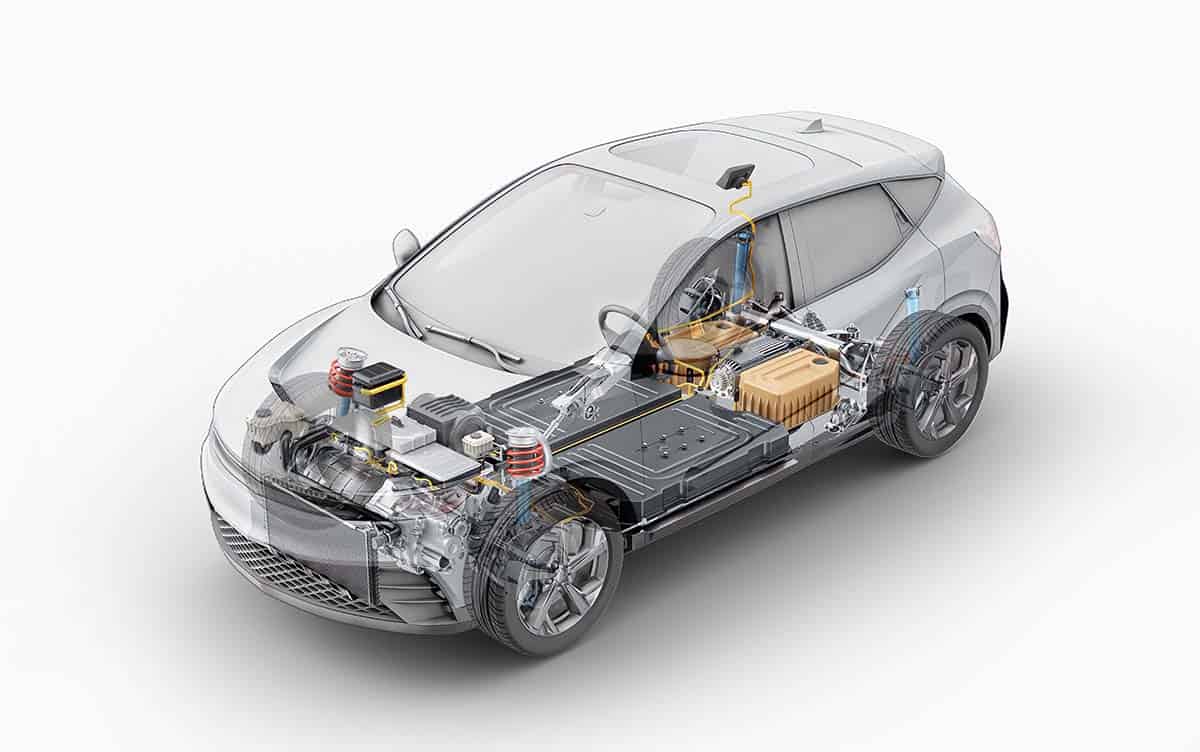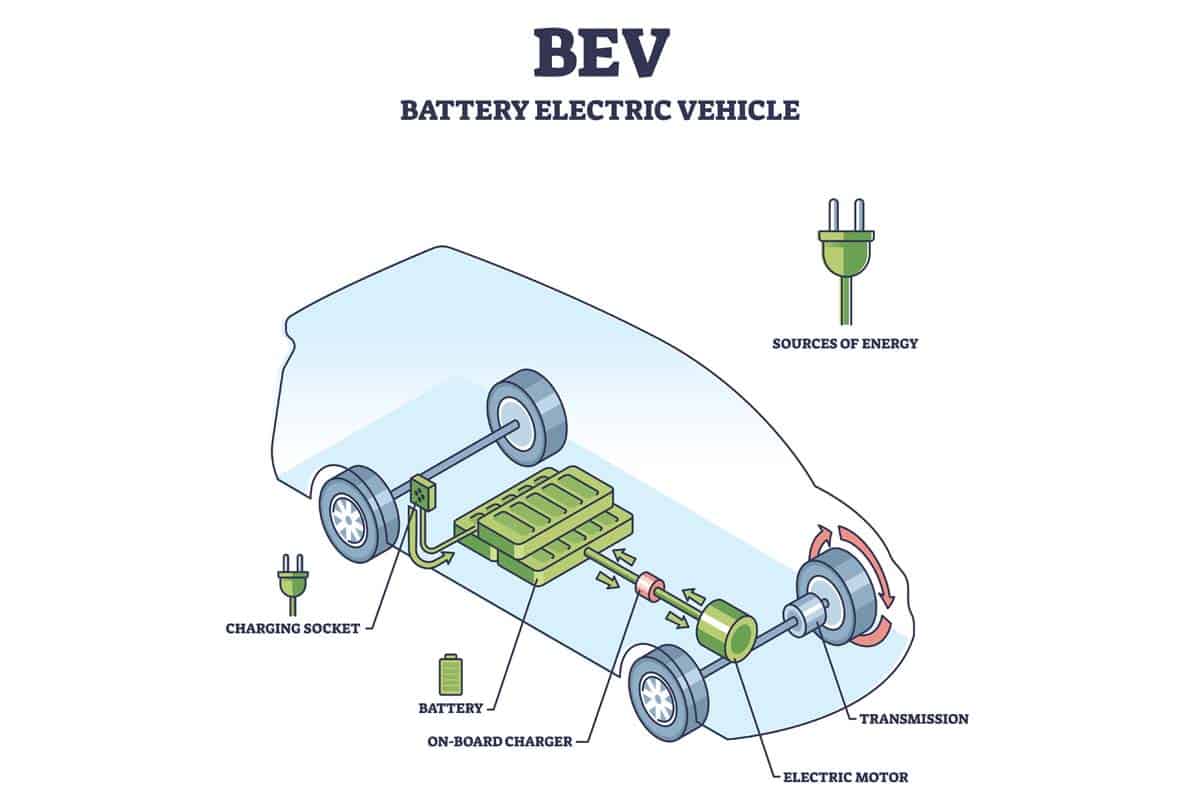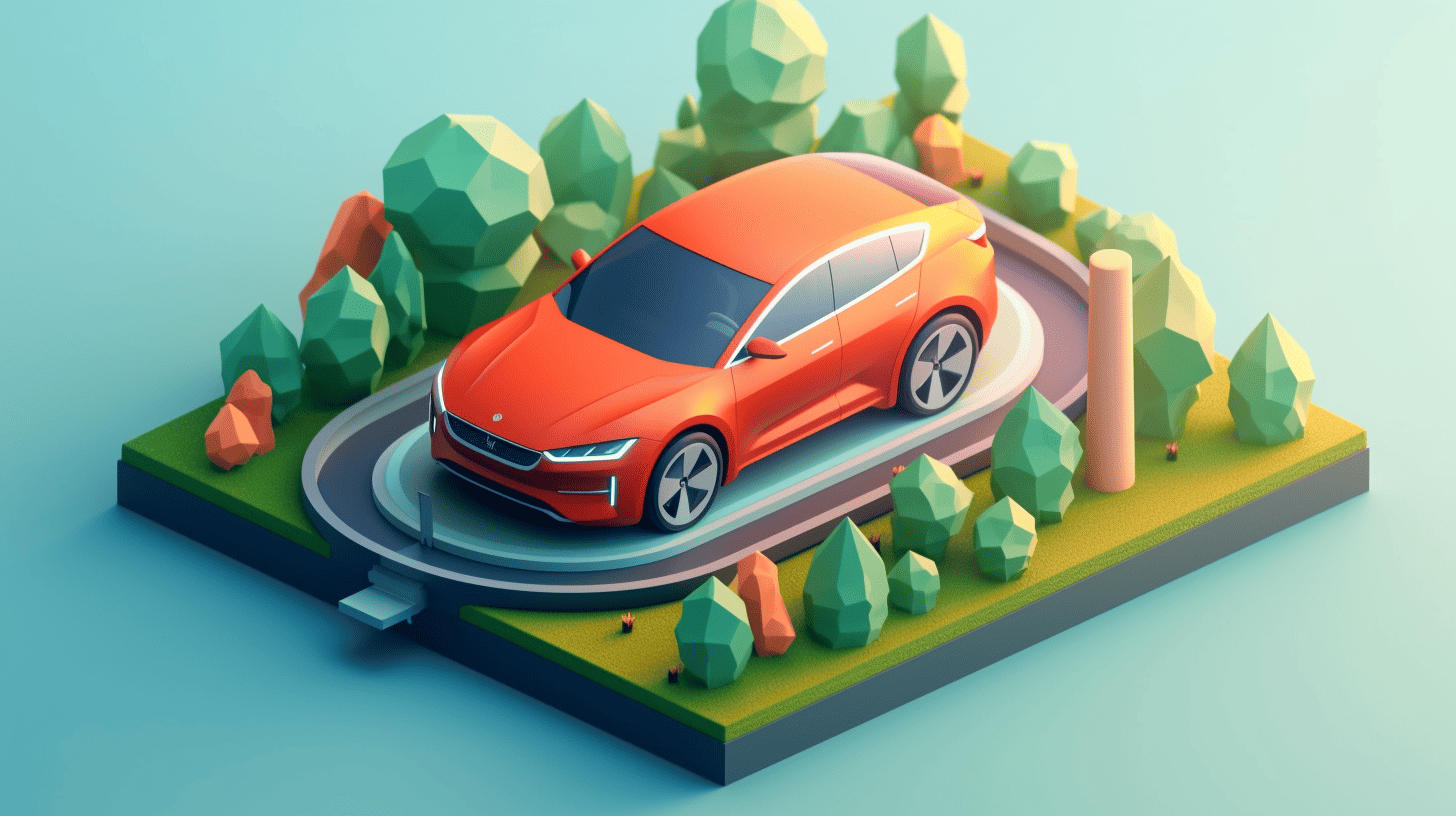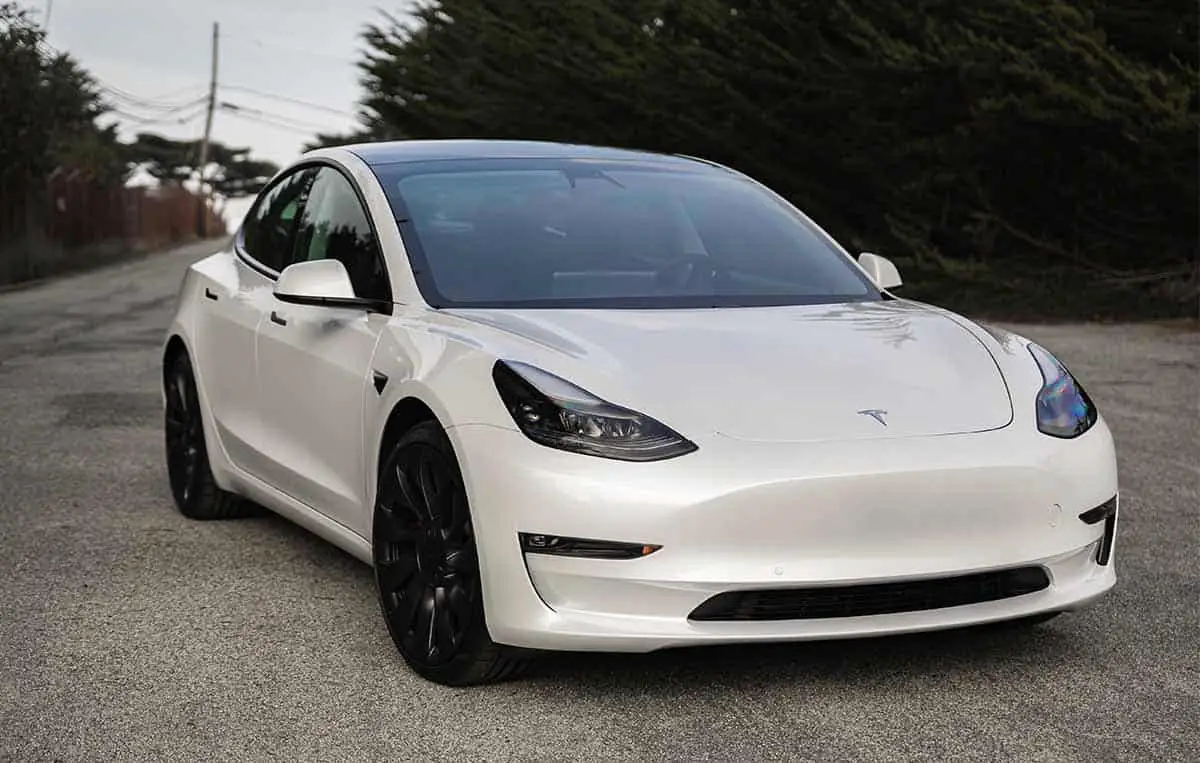The term “Battery Electric Vehicle” (BEV) refers to a type of electric vehicle (EV) that relies solely on rechargeable battery packs for power, with no secondary source of propulsion such as a hydrogen fuel cell or internal combustion engine.
BEVs operate using an electric motor, which harnesses energy stored in the battery pack to drive the vehicle. The battery pack can then be recharged at charging stations or even at home, using a power outlet.
In addition to their environmental benefits, BEVs are known for their smooth, quiet operation and instant torque delivery, offering a unique driving experience compared to conventional internal combustion engine vehicles.

Battery Electric Vehicle Overview
A battery electric vehicle (BEV) is a type of electric vehicle (EV) that solely relies on rechargeable battery packs for its energy source, with no additional sources of propulsion such as an internal combustion engine or hydrogen fuel cell.
BEVs, also known as all-electric vehicles, utilize electric motors and motor controllers for power instead of traditional engines.
The energy stored in the battery pack drives the electric motor, which in turn powers the vehicle.
The battery pack can be charged using external charging stations and to some extent through regenerative braking technology, which captures energy typically lost during deceleration and redirects it to recharge the battery.
In a BEV, the power from the battery is delivered to the electric motor through a controller.
The controller’s job is to manage the amount of power sent to the motor based on the input from the throttle.
As the driver presses the throttle, the controller increases the power delivered to the motor to accelerate the vehicle.
One of the key advantages of BEVs is their environmental impact, as they produce zero tailpipe emissions, including greenhouse gas emissions (GHGs).
This makes them fall under the category of “zero-emission vehicle” (ZEV), and an excellent choice for reducing GHGs and improving air quality, especially in urban areas with heavy traffic congestion.
When comparing BEVs to other types of electric vehicles like hybrid-electric vehicles (HEV) and plug-in hybrid-electric vehicles (PHEV), it’s important to note that BEVs rely solely on their battery packs.
In contrast, HEVs and PHEVs use a combination of battery and gasoline or diesel engines for power.
As a result, BEVs typically have a simpler mechanical design and lower maintenance costs, but may also have a shorter driving range when compared to their hybrid counterparts.
Key Components of BEVs
Battery Electric Vehicles (BEVs) are vehicles that rely solely on electricity stored in rechargeable battery packs to power electric motors. This section will cover three main components of BEVs: battery packs, electric motors, and controllers.
Battery Packs
A crucial part of a BEV is the battery pack, which provides the vehicle’s electric power source.
The most common type of battery used is the lithium-ion battery pack. These battery packs store the electrical energy needed to power the vehicle’s electric motor.
A significant factor for BEVs is the battery pack capacity, measured in kilowatt-hours (kWh), which determines the vehicle’s range between charges.
Larger battery packs can offer longer driving distances, but they can also increase the vehicle’s total cost and weight.
Electric Motors
BEVs use electric motors instead of internal combustion engines to power the wheels. Electric motors have several advantages over conventional engines, such as higher efficiency, instantaneous torque, and fewer moving parts, resulting in reduced maintenance costs.
There are various types of electric motors, including AC induction motors, permanent magnet motors, and switched reluctance motors. The choice of motor depends on factors such as cost, efficiency, and performance requirements.
Controllers
In a BEV, the controller is responsible for managing the power flow from the battery pack to the electric motor. It interprets the driver’s input via the accelerator pedal and regulates the amount of current supplied to the motor, thereby controlling the vehicle’s speed.
Controllers also manage regenerative braking technology, which converts the energy generated during deceleration back into stored energy in the battery pack, thus improving the overall efficiency and range of the BEV.

Charging Options and Infrastructure
Electric vehicles (EVs), particularly battery electric vehicles (BEVs), rely on a robust charging infrastructure to ensure their usability and functionality.
The charging infrastructure comprises various charging levels, types of charging stations, and their connection to the grid. This section provides an overview of these key aspects.
Charging Levels
There are three primary levels of charging available for BEVs:
- Level 1: This is the most basic form of charging, in which an EV is plugged into a standard 120-volt household outlet. Level 1 charging typically provides a charge rate of around 3-5 miles of range per hour, making it suitable for overnight charging or for vehicles with smaller battery capacities. However, it may be inadequate for longer trips or larger batteries.
- Level 2: More efficient than Level 1, Level 2 charging utilizes a 240-volt outlet (similar to those used for large appliances). This method can deliver a charge rate of approximately 10-20 miles of range per hour, allowing for faster charging times and the ability to recharge larger batteries more effectively. Level 2 chargers are commonly found at charging stations in public places, workplaces, and residential garages.
- DC Fast Charging: As the fastest form of charging currently available for BEVs, direct current (DC) fast charging can recharge a vehicle’s battery up to 80% in as little as 30 minutes. This rapid charging capability makes DC fast charging optimal for long-distance travel. However, its high-power demands must be managed carefully in relation to the grid.
Charging Stations
Charging stations are essential pieces of the EV infrastructure, providing a location where BEVs can recharge their batteries. There are two main types of charging stations:
- Public Charging Stations: These stations are typically located in areas with easy access for BEV users, such as shopping centers, parking lots, and multifamily residential complexes. Public charging stations offer both Level 2 and DC Fast Charging options in most cases, but it’s important to note that some stations may require a subscription, payment, or both for usage.
- Private Charging Stations: Primarily used in residential settings, private charging stations can be installed by BEV owners in their garages or designated parking spaces. These stations facilitate convenient overnight charging and are typically limited to Level 1 or Level 2 charging options.
Integration with the grid must be taken into consideration when developing the charging infrastructure, as higher demand for EV charging can place increased strain on the grid.
Fortunately, advances in charging technologies and grid management strategies are constantly being developed to better accommodate this growing demand.
BEV Performance and Range
Battery electric vehicles (BEVs) have unique performance characteristics compared to conventional internal combustion engine vehicles. This section will examine the acceleration and driving range of BEVs, highlighting their key features and capabilities.
Acceleration
BEVs tend to accelerate faster than traditional gasoline-powered vehicles, primarily due to their electric motor’s ability to deliver instant torque.
Electric motors can reach maximum torque at nearly zero RPM, providing a smooth and powerful acceleration from a standstill. This results in a confident, responsive driving experience and often, impressive 0-60 mph times.
Additionally, BEVs usually have simplified transmission systems, often with just a single gear ratio. This allows for seamless power delivery without the need for gear changes, further enhancing the driving experience and acceleration capabilities.
Driving Range
The driving range of a BEV is determined by the capacity of its rechargeable battery pack and the efficiency of its electric motor. In recent years, advancements in battery technology have led to significant improvements in driving range, making BEVs more suitable for both daily commuting and long-distance travel.
The range of BEVs available on the market today varies greatly, from around 100 miles for some entry-level models to over 300 miles for more advanced and luxurious options.
It’s worth noting that factors such as temperature, driving style, and terrain can impact the actual driving range, so real-world performance may differ from the manufacturer’s claims.
To address “range anxiety”, which is the fear of running out of battery power before reaching a charging station, many BEVs come equipped with sophisticated energy management systems and regenerative braking technology that help optimize battery usage and recover energy during deceleration.

Comparison to Other Vehicle Types
Hybrid Electric Vehicles (HEVs)
Hybrid electric vehicles combine a traditional internal combustion engine (ICE) with an electric motor powered by batteries.
The batteries are not charged by plugging in but are recharged through a process called regenerative braking, where the energy generated during braking is captured and stored in the battery.
Thus, HEVs do not have the range limitations of battery electric vehicles (BEVs). However, since they still rely on gasoline, HEVs produce more emissions than pure electric vehicles.
Plug-in Hybrid Electric Vehicles (PHEVs)
Plug-in hybrid electric vehicles exist between HEVs and BEVs. They have both an internal combustion engine and an electric motor powered by a rechargeable battery.
The difference is that PHEVs can be charged by plugging into the grid, allowing for more extended electric-only driving. This added flexibility results in lower tailpipe emissions than HEVs while still providing a fallback option for longer trips when battery power runs out.
Fuel Cell Electric Vehicles (FCEVs)
Fuel cell electric vehicles operate using hydrogen fuel cells, which combine hydrogen and oxygen to generate electricity without combustion.
This process produces water as the only byproduct, making FCEVs a zero-emission alternative to ICE vehicles. They also offer refueling times similar to gasoline-powered cars, which can be an advantage over BEVs and their potentially long charging times.
However, hydrogen infrastructure is limited, and FCEVs currently have a higher purchase price than comparable electric or ICE vehicle.
Internal Combustion Engines (ICEs)
Internal combustion engines, found in the majority of vehicles on the road today, run on fossil fuels like gasoline or diesel.
While ICEs have been refined over the years for improved efficiency and reduced emissions, they still produce harmful greenhouse gases and contribute to global climate change.
Battery electric vehicles, plug-in hybrid electric vehicles, and fuel cell electric vehicles present cleaner alternatives to ICE-powered cars, with each type offering advantages and disadvantages depending on individual needs and preferences.
Environmental Impact of BEVs
Emissions Reduction
Battery electric vehicles (BEVs) play a significant role in reducing emissions, as they generate zero tailpipe emissions during operation.
Unlike traditional internal combustion engine vehicles that emit greenhouse gases and other pollutants, BEVs rely on chemical energy stored in batteries and produce no direct emissions.
This results in a substantial decrease in air pollution, contributing to a healthier environment and improved air quality in urban areas.
However, it is essential to consider the indirect emissions associated with BEVs. Manufacturing the BEV’s batteries and charging the vehicles using electricity from the grid can still generate emissions.
The actual emission reduction depends on the energy mix used in the electricity production. Utilizing renewable energy sources for charging BEVs can further minimize the environmental footprint and lead to a higher emissions reduction.
Fossil Fuel Reduction
The widespread adoption of BEVs also has a significant impact on reducing fossil fuel consumption. As BEVs use electricity instead of gasoline or diesel as their energy source, they reduce the reliance on or dependency on fossil fuels because electricity can be generated from other sources.
This, in turn, helps in limiting the contribution of the transportation sector to global warming and climate change.
By replacing conventional vehicles with BEVs, countries can avoid the environmental and geopolitical challenges associated with fossil fuel extraction, transportation, and usage.
Moreover, BEVs can promote the use of cleaner and renewable energy sources in the transportation sector.
It is important to note that achieving a 100% zero-emission vehicle fleet will require a significant shift in technology, infrastructure, and policy.
Still, the environmental benefits of BEVs in terms of emission and fossil fuel reduction are undeniable and can contribute positively to worldwide efforts to mitigate climate change.
Popular BEV Models and Manufacturers
Tesla Model 3
The Tesla Model 3 is a highly popular battery electric vehicle (BEV) designed and produced by Tesla, Inc. This all-electric sedan has gained worldwide recognition for its impressive performance, long range, and advanced technology.
The Model 3 comes in three different variants: Standard Range Plus, Long Range, and Performance, each offering different levels of driving range, acceleration, and top speeds.
Nissan Leaf
The Nissan Leaf is a widely recognized BEV produced by Nissan, a Japanese automaker. With its launch in 2010, the Leaf became one of the first mass-market electric vehicles globally.
The Leaf is known for its affordability and practicality, catering to drivers who prioritize efficiency and environmental friendliness. There are two battery options available: a 40 kWh battery with a range of 150 miles and a 62 kWh battery with a range of up to 226 miles.
Renault Zoe
The Renault Zoe is a popular European BEV manufactured by French automaker Renault. The compact hatchback is praised for its efficiency, range, and affordability.
The latest model offers a 52 kWh battery, allowing for a range of up to 245 miles on a single charge. With its compact size and practical features, the Zoe is an excellent option for urban drivers and commuters.
Audi E-Tron
Audi has entered the electric vehicle market with the Audi E-Tron, a luxurious BEV SUV. The E-Tron offers a spacious interior, a comfortable ride, and advanced technology features.
Powered by a 95 kWh battery, the E-Tron delivers a range of up to 204 miles, with the ability to recharge quickly at up to 150 kW. The Audi E-Tron is a suitable choice for customers looking for a high-quality, premium electric SUV.
Mini E
The Mini E is an all-electric version of the beloved Mini Cooper. Produced by BMW, this compact BEV hatchback offers a unique blend of style, performance, and efficiency.
The Mini E features a smaller 32.6 kWh battery, delivering a range of up to 110 miles on a single charge. With its compact size and sporty handling, the Mini E appeals to drivers who want an exciting and environmentally friendly driving experience.
Additional BEV Applications
Battery Electric Vehicles (BEVs) extend beyond just cars; in fact, many different applications take advantage of the clean and efficient technology provided by BEVs.
Understanding the variety of these additional applications can provide a comprehensive view of the impact of electric power on various industries and modes of transportation.
Motorcycles: Electric motorcycles offer riders a quiet and efficient alternative to traditional gas-powered motorcycles.
They typically require less maintenance and can be charged at home, making them a convenient option for those seeking a greener and more practical mode of transportation.
Bicycles: Electric bicycles, often referred to as e-bikes, use a small electric motor to assist the cyclist with pedaling. These bikes provide riders with additional power to tackle hills and longer distances while still maintaining the fitness benefits of traditional biking.
Scooters: Electric scooters are gaining popularity as an environmentally friendly and cost-effective means of urban transportation, providing an emission-free solution for short trips. Some scooters are foldable for convenient storage and transport.
Skateboards: Electric skateboards use a small motor to propel the rider, offering an exciting and efficient way to travel short distances. These boards offer various speed settings and often come with a handheld remote for added control.
Watercraft: Electric-powered boats and personal watercraft are becoming an increasingly popular option for recreational and professional use in the boating industry.
They provide a quiet and emission-free alternative to traditional gasoline or diesel engines, benefiting both the environment and the user experience.
Forklifts: Electric forklifts play a vital role in warehouse and industrial settings, offering a cleaner and more efficient alternative to traditional internal combustion engine (ICE) forklifts.
These forklifts eliminate harmful emissions, provide a quieter operation, and generally require less maintenance than their non-electric counterparts.
In summary, a wide range of applications has embraced the use of battery electric technology, emphasizing its potential for a more sustainable and efficient future across various industries and transportation modes.

Frequently Asked Questions
What are the main components of a BEV?
A battery electric vehicle (BEV) primarily consists of a battery pack, an electric motor, a motor controller, and a charging system.
The battery pack stores the energy needed to power the electric motor, which in turn drives the vehicle.
The motor controller manages the power delivered from the battery to the motor depending on the throttle input.
How do BEV charging systems work?
Charging systems in BEVs connect the vehicle’s battery pack to an external power source, such as a home charger or public charging station.
The charger converts the incoming AC power to DC power, which is used to charge the battery directly.
BEVs also employ regenerative braking, which recovers energy usually lost during braking by converting kinetic energy back into electricity, further charging the battery.
What are the differences between BEV, PHEV, and HEV?
A BEV (Battery Electric Vehicle) relies solely on a battery and an electric motor for power, with no secondary propulsion system.
A PHEV (Plug-in Hybrid Electric Vehicle) combines a battery-powered electric motor with an internal combustion engine (ICE).
PHEVs can be charged externally and operate in both electric and hybrid modes.
An HEV (Hybrid Electric Vehicle) also has both a battery-powered electric motor and an ICE, but cannot be charged externally, relying on regenerative braking and the ICE for battery charging.
What are the advantages and disadvantages of BEV technology?
Advantages of BEV technology include zero tailpipe emissions, lower operating costs, and quieter operation compared to combustion-engine vehicles.
Additionally, the usage of a simpler drivetrain results in fewer parts requiring maintenance. However, disadvantages include a limited driving range compared to gasoline-powered vehicles, longer charging times, and a need for charging infrastructure.
How do BEV battery capacities affect driving range?
A BEV’s driving range is directly affected by its battery capacity, which is typically measured in kilowatt-hours (kWh).
The larger the battery capacity, the greater the energy stored and thus the greater the driving range.
However, factors such as vehicle size, weight, aerodynamics, and energy usage of auxiliary systems can also impact the driving range.
What is the current state of BEV battery technology?
BEV battery technology has steadily improved over the past several years, with increased energy density, longer lifespans, and reduced costs.
Lithium-ion batteries have become the primary choice for BEV manufacturers due to their high energy density and favorable charge/discharge characteristics.
Researchers and manufacturers continue to explore new battery chemistries and technologies to further enhance the performance and affordability of BEVs.
- Tesla Charger Installation Cost (Home Setups) - March 1, 2024
- Tesla Phone Key Disconnected (Troubleshooting Guide and Quick Fixes) - March 1, 2024
- Tesla FSD 12 (Explained) - March 1, 2024
